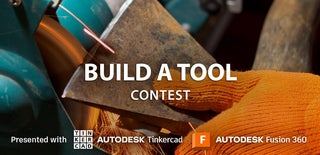Introduction: DIY Cheap and Quiet Air Assist (Laser Cutter Upgrade)
Laser cutters are becoming increasingly popular. It is a revolution very similar to what we've seen in 3D printers. The ability to go from idea to a finished project in no-time was always appealing, but as the prices of laser cutters are dropping, more and more people decide it's time to get a new hobby.
I bought my xTool D1 laser cutter a few months ago (thanks to the generous prizes here on instructables!), and I love it. I make new things every week. I actually retired much of my workshop ever since I got my laser cutter because I don't really need that many things anymore.
But the problem is, cheap lasers like mine have their drawbacks - they lack many features found on the high-end laser cutters. Nothing essential usually, you can start cutting right away, but the cuts might not be perfectly clean and usually the laser doesn't come with an enclosure. So, to get the most out of your budge laser cutter, you'll need to upgrade it. If you buy all of the available commercially available upgrades the expenses pile up, and you can easily find yourself spending on upgrades more than you did for the laser itself.
In this instructable I'll show you how to make arguably the most essential upgrade of them all - an air assist. It solves the common issue of wood charring by pointing a jet of air at the point being cut by the laser. This pushes away any small and residues formed when the wood is being cut before any of it gets to cling onto the wood. I made my air assist for around 40$, which is by far the cheapest one I could find (the one sold by the manufacturer of my laser cutter costs 139$ on discount). It makes the most of a small and quiet air pump, and solves the charring problem altogether.
All of the files and links needed for this project are included so you can have your air assist built and ready without any hustles. It's an easy upgrade actually!
I hope you find this useful, and if you have any questions or comments, let me know!
* If you want to make an air assist for a different laser cutter, you can follow along to see how I designed mine and make your version!
Supplies
Parts needed:
- Air pump (30L/min is more than enough for my laser - larger pump = more noise). I bought this one for around 37$ (YYAP300 version).
- Air tube (4mm inner diameter, 6mm outer diameter). I bought this one for around 4$ (affiliate link! it's a the air tube I tested, but you can buy anything else if you prefer).
- A few zip-ties (4-5).
- Access to a resin printer to print the nozzle. If you don't have one, don't worry - I added a link to a website that finds someone near by to print for you (costs about 5-6$ for the part needed here).
Step 1: Video Version
For those who want to see a narrated video version the project, feel free to watch the one I made :)
By the way, if you want to support my projects subscribing to my new YouTube channel the best way to do that! :) Thank you so much!
Step 2: Design
If you just want the bottom lines, skip this part. I thought sharing my design process might be helpful to some.
I looked online to use other people's designs, but I couldn't find anything I like from top to bottom. The were all pretty bulky and required huge air pumps. I just didn't like the air-flow design on any of them. The version closest to what I wanted to make was made a person called 'GeeksAtLarge' on thingieverse, but I didn't quite like their design either, since it required installing a 3D printer nozzle, which, to my opinion, does more damage than good. So I set out to design my taken on the air assist.
I wanted to design the air assist so that it doesn't require any modifications to my laser cutter. No precise drilling or anything else irreversible. This required designing a complex model with the air assist tube bending around the light shield. To do it successfully, I wanted to have an accurate 3D model of my laser module.
To create a 3D model of the laser module, I took a few pictures from different angles with a ruler next to them. By having a ruler inside the image I could translate distances in the image, which are measured in pixels, into physical distance units (mm in my case, inchs for those who prefer). I did this in a software called ImageJ. It's a free software that many scientists use.
To calibrate pixels into physical units (image 1-3):
- Images should be taken such that the object is close to the middle of the picture and as perpendicular to the camera as possible (not in an angle).
- Use the line tool to draw a line between two ticks on the ruler (or along a different object with a known distance). It's best to draw a line that covers a large distances.
- Click the 'Analyze' tab and go to 'Set Scale'. Change the 'Known distance' to the actual distance between the two ticks. Set the units to the desired physical units, and confirm.
You can now measure any distance you want in the picture. Just draw a line between the desired points, and press 'ctrl' + 'm' to measure. *** Make sure you only measure objects in the same plane as the ruler!*** Otherwise, the measurements will be inaccurate (small deviations are fine).
Model the laser module in your favorite CAD software (such as Autodesk Fusion 360) according to the measurements. I like to draw a rought design and then set the distances according to the image.
Once I had a 3D model of the laser module, I designed the air assist itself. It was really nice to do it this way because I could make sure nothing clashes. This worked perfect, my print was spot on right on version 1.0 :)
Step 3: Print
There are a few variations to the xTool D1 laser module differing in the diameter of the lens. Measure the diameter of the lens, and print out the right air assist nozzle in a resin printer (STL's attached).
I printed mine on an Elegoo Mar 3, with the famous SirayaTech standard (quick) resin at 35 micros per layer - it worked great.
If you don't have access to a resin printer, you can ask around to find some, or you can get the nozzle printed for you using these links (costs around 5-6$):
You'll also need to print out the tube holder (STL attached), which is kind of a guide for the air tube so the nozzle doesn't get twisted when the laser module is moving around. This part is actually better off printed in a FDM printer (a regular 3D printer).
Attachments
Step 4: Assembly
Assembly is easy. Follow these simple steps:
- Remove the laser module from its rail.
- Unscrew the two bolts holding the light shield and remove the light shield (image #1).
- Install the air assist nozzle onto the laser lens (image #2).
- Put the lightshield back on, and screw the two bolts back into place (image #3).
- Install the laser module back in place.
That's it! The nozzle is in place :)
Now connect it to an air tube:
- Thread the air tube through the tube holder (printed in the previous step).
- Connect the air tube to the air assist nozzle (image #4).
- Secure the tube holder to on of the bolts at the top of the laser module (image #5).
- Loosly hold the air tube using zip-ties (image #6). Make sure the laser is free to move around and that the air tube doesn't have any twists in it.
Connect the air tube to the air pump.
That's it, you have an air assist!
Step 5: Testing
To test the air assist, I cut two hexagons out of 3.5mm plywood. The results really surprised me. Without the air assist, the part was all charred up as usual. Turning the air assist on removed the charring altogether.
How does an air assist work?
You might think that air assist works by putting out flames or cooling the area around the point being cut, but that's actually not the case. The charring is caused by smoke and micro-particles that are streaming out of the point being cut. To avoid charring all we need to do is to blow away the smoke before it clings onto the wood. My design aimed to do exactly that - it aims a minimal jet of air exactly at the right point. That's why I didn't need a huge, expensive, air pump, and why my air assist turned out to be very quiet as well.
In the 3rd image you can see two images of an identical piece being cut by the laser. On the left, the air assist is off, and on the right it's turned on. Notice that when the air assist is turned off, smoke builds up around the region being cut. This not only causes charring, but also decreases the laser power by obscuring the laser beam. So an air assist is not only useful for getting clean cuts, but also to get the most power out of your laser!
If you like my instructable and want to see more, you're welcome
to visit my instructables page and my website

Second Prize in the
Build a Tool Contest


















